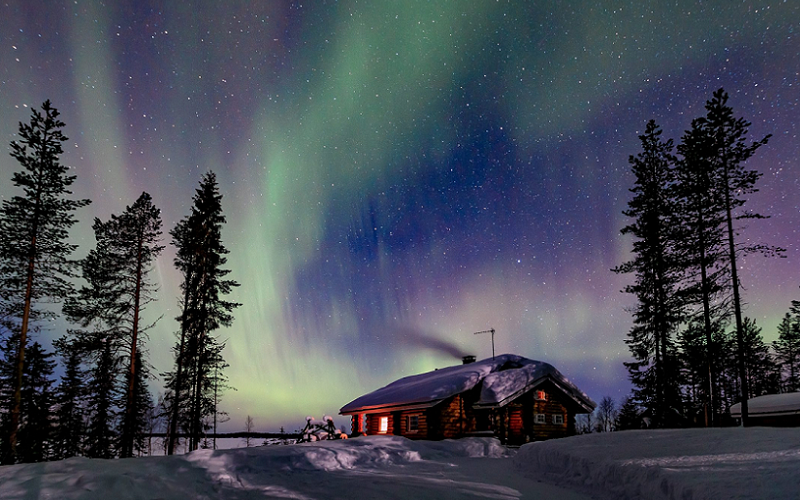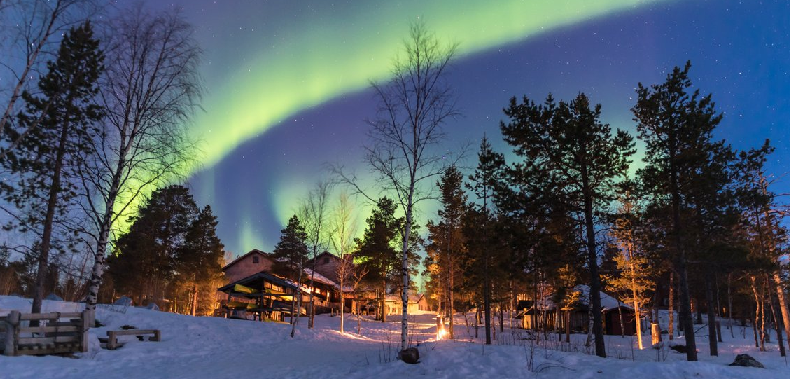
The Northern Lights, or Aurora Borealis, is one of nature’s most mesmerizing spectacles. While many travel far and wide to witness this celestial wonder, few are aware of the deeper, silent influence it might have on our mental health.
Nature has a profound way of touching our souls, of grounding us and reminding us of the larger cosmos we’re a part of. The Northern Lights, or Aurora Borealis, is one of nature’s most mesmerizing spectacles, illuminating the night skies with ethereal hues and dancing patterns. While many travel far and wide to witness this celestial wonder, few are aware of the deeper, silent influence it might have on our mental health. As the play of colors illuminates the vast expanse above, it may also ignite feelings of wonder, reflection, and even healing within us.
Contents
Understanding the Phenomenon: The Northern Lights
The beauty of the Northern Lights has fascinated humans for millennia. Before getting into its psychological effects, it’s crucial to understand what the auroras are and the science behind this awe-inspiring phenomenon.
Scientific Explanation of Auroras
The dance of colors in the sky isn’t just a random act of nature; it’s a result of complex interactions between our planet’s magnetic field and charged particles from the sun.
Solar Wind and Earth’s Magnetic Field
Originating from the sun, a stream of charged particles called the solar wind hurtles towards Earth. When this solar wind approaches our planet, it interacts with Earth’s magnetosphere, a region surrounding our planet dominated by its magnetic field. As these charged particles collide with the gases in our atmosphere, particularly oxygen and nitrogen, they become excited and emit light. This light manifests as the shimmering curtains or rays that we recognize as the Northern Lights.
Colors and Visibility
The variation in colors is primarily due to the type of gas and the altitude at which the collision occurs. Oxygen at higher altitudes can produce red hues, while at lower altitudes, it can yield greens and sometimes even browns. Nitrogen, on the other hand, can produce purples, blues, and pinks. The intensity and visibility of these lights largely depend on solar activity, and they’re typically more vivid and frequent during periods of high solar flare activity.
Historical and Cultural Significance of Auroras
The Northern Lights have been more than just a visual treat for humanity. They have been woven into the cultural and spiritual tapestry of societies that have been fortunate enough to witness them regularly.
Indigenous Interpretations and Beliefs
For the indigenous Sami people of Northern Scandinavia, the auroras were seen as a manifestation of the souls of their ancestors. In other cultures, they were believed to be pathways to the gods or even celestial battles. The Alaskan Inuit, for instance, believed the lights were the spirits of animals they hunted, like seals, salmon, and deer. These interpretations often highlighted the deep connection between the inhabitants and the environment they lived in [1].
Modern-Day Fascination
Today, while science has provided explanations for the auroras, their enchantment remains undiminished. Many view them as a bucket-list experience, traveling to remote regions for a chance to witness this celestial ballet. Photographers and artists seek them out for inspiration, and literature is replete with references to their ethereal beauty. Despite our scientific understanding, the Northern Lights still hold an element of mystery and allure, drawing individuals from all over the world to marvel at their beauty.

Nature’s Effects on Mental Health: A Brief Overview
The relationship between nature and human well-being isn’t a new area of interest. For centuries, poets, philosophers, and thinkers have ruminated on the therapeutic effects of the natural world. Today, modern research continues to affirm the many ways nature nurtures our minds.
The Healing Power of Nature
Throughout history, nature has been a refuge for those seeking solace, inspiration, and rejuvenation. Let’s explore the mechanisms through which the great outdoors impacts our psychological health.
Stress Reduction and Relaxation
Nature acts as a balm for our often overstimulated minds. The natural environment encourages relaxation by reducing the production of cortisol, a stress hormone. The gentle sounds of rustling leaves, the soothing hues of green and blue, and the fresh scent of earth all contribute to a state of relaxation. A simple walk in a park or forest can lower blood pressure, heart rate, and muscle tension. This therapeutic effect is so profound that even looking at pictures of nature can evoke relaxation [2].
Increased Positive Emotions and Well-being
Exposure to nature not only reduces negative feelings but also amplifies positive emotions. Natural settings, whether it’s a beach, forest, or mountain, have been linked to heightened feelings of awe, wonder, and joy. Such positive emotions can foster a sense of greater life satisfaction, improved mood, and even increased kindness and cooperation with others.
Light and Its Influence on Mental Health
Light, both natural and artificial, plays a pivotal role in regulating our mood and cognitive functions. This connection is especially profound when we consider the seasonal changes in light and their effects on our psyche.
Seasonal Affective Disorder (SAD)
SAD is a type of depression that emerges during specific times of the year, typically in the fall and winter months when daylight becomes sparse. The reduced level of sunlight can lead to a drop in serotonin, a neurotransmitter associated with mood, and an imbalance in melatonin, which regulates sleep and mood. Individuals with SAD may experience lethargy, mood swings, and a persistent gloomy mood. The therapeutic use of light, known as light therapy, has been effective in treating SAD, underscoring the profound impact of light on our mental health.
Benefits of Natural Light Exposure
Natural light has benefits that extend beyond the treatment of SAD. Regular exposure to natural light boosts our vitamin D levels, which is essential for mood regulation and overall brain health. Moreover, natural light enhances sleep quality by regulating our circadian rhythm. A stable circadian rhythm not only ensures restorative sleep but also promotes better mental clarity, mood, and cognitive functioning throughout the day [3].
In the grand tapestry of nature’s offerings, the Northern Lights are a unique and magnificent thread. Their sheer beauty and ethereal presence in our world hint at the possibility of deeper effects on our mental landscape. As we’ve seen, the natural world holds a mirror to our internal states, offering both reflection and relief.
The Silent Influence of the Auroras on Mental Health
While the broad strokes of nature’s influence on mental health are now better understood, the unique experience of witnessing the Northern Lights carries its own set of emotional and cognitive implications. The auroras, with their luminescent dance across the polar skies, are not just a visual feast but also a source of introspection, wonder, and profound emotional experiences for many who behold them.
Personal Accounts and Experiences of Auroras on Mental Health
Personal narratives often capture the essence of an experience more vividly than any research can. Through the eyes and words of those who’ve stood beneath the Northern Lights, we can gain insights into the depth of emotion and thought these phenomena evoke.
The Feelings of Awe and Wonder
A common thread among aurora viewers is the overwhelming sense of awe. This emotion, characterized by a mix of wonder, reverence, and sometimes even a touch of fear, has been linked to feelings of interconnectedness and a more significant purpose. Witnessing the vastness and ethereal beauty of the Northern Lights can lead to a shift in perspective, making personal worries seem trivial in the grand scheme of things. It’s a humbling experience that can instill a renewed appreciation for life and the universe [4].
Connection to Something Greater
Many describe the experience of watching the auroras as spiritual or transcendent. Regardless of religious beliefs, viewers often feel a deep connection to something beyond themselves – be it nature, the cosmos, or a higher power. This sensation of being part of a larger whole can offer comfort, reduce feelings of isolation, and foster a sense of belonging.
Psychological Research Findings on Auroras and Mental Health
While personal accounts provide rich qualitative data, scientific research offers quantitative insights into the effects of the Northern Lights on our psyche.
Impact on Mood and Emotional States
Although direct research on auroras is limited, studies on similar awe-inspiring natural phenomena suggest a positive impact on mood. Experiences that evoke strong feelings of awe, like viewing the Northern Lights, can lead to reduced anxiety, improved mood, and a heightened sense of well-being. The transformative nature of such experiences may also help in resilience-building and coping with life’s challenges.
Inspiration for Creativity and Reflection
The Northern Lights, with their ever-changing patterns and colors, can be a source of inspiration. Artists, writers, and even scientists have cited the auroras as a muse, leading to bursts of creativity and novel ideas. Moreover, the tranquil setting often associated with aurora viewing – remote, quiet landscapes – provides an environment conducive to deep reflection and introspection. This setting, combined with the visual spectacle, can be a catalyst for personal growth and self-discovery.

The Therapeutic Potential of Aurora Viewing
The mental health benefits of nature are well-established, and specific natural settings or phenomena can sometimes offer their own unique therapeutic potential. The auroras, with their ethereal dance and calming colors, might just be one of nature’s most potent therapeutic spectacles.
Nature-based Therapy Concepts
Before diving into the unique qualities of the auroras, it’s essential to understand some foundational concepts in nature-based therapy. These therapies harness the healing powers of the natural world to promote well-being and mental health.
Forest Bathing and its Benefits
Originating from Japan, “Shinrin-yoku” or forest bathing, is a practice that involves immersing oneself in a forest environment. It doesn’t entail any specific activities but focuses on being present and absorbing the forest’s sights, sounds, and scents. Research has shown that forest bathing can reduce stress, improve mood, boost the immune system, and increase feelings of vitality. The principle behind such benefits is the deep connection humans have evolved to have with nature, and the tranquility that natural settings offer to our often chaotic minds [5].
Comparison with Aurora Experiences
Much like forest bathing, aurora viewing is a passive experience where one immerses themselves in the spectacle. While forests provide a sensory experience rooted in the sights, sounds, and smells of the woods, the auroras engage our visual sense profoundly. The quiet, often isolated places from which the Northern Lights are viewed amplify the experience, making it a deeply meditative and reflective one. Just as the forest grounds us with its earthiness, the auroras lift our spirits with their celestial dance, making both experiences therapeutic in complementary ways.
Integrating Aurora Viewing in Therapeutic Practices
Given the profound emotional responses evoked by the Northern Lights, there’s potential for integrating this experience into therapeutic practices, either as a standalone approach or complementing existing therapies.
Challenges and Considerations
However, leveraging the auroras therapeutically isn’t without challenges. Their unpredictability, the need for specific geographic locations, and the potential expense can make it difficult to incorporate as a regular therapeutic tool. Additionally, it’s essential to ensure that individuals are physically prepared and comfortable in colder, remote settings where the lights are most visible. Mental health professionals considering this approach must weigh these factors against the potential benefits.
Potential for Mental Health Retreats
One feasible approach is organizing mental health retreats centered around aurora viewing. These retreats can combine traditional therapeutic activities like group therapy, mindfulness exercises, and journaling with the experience of watching the Northern Lights. Such retreats, located in serene, remote areas, offer participants a dual benefit: the therapeutic effects of nature and the profound impact of the auroras on emotional well-being.
References
[1] Auroras are dangerous for people prone to mental illness
[2] The Effects of Geomagnetic Activity on Human Behaviour
[3] The Northern Lights have captivated humans for thousands of years
[4] Scientists Prove Human Brain Can Detect Earth’s Magnetic Field
[5] Northern lights (aurora borealis): What they are & how to see them

